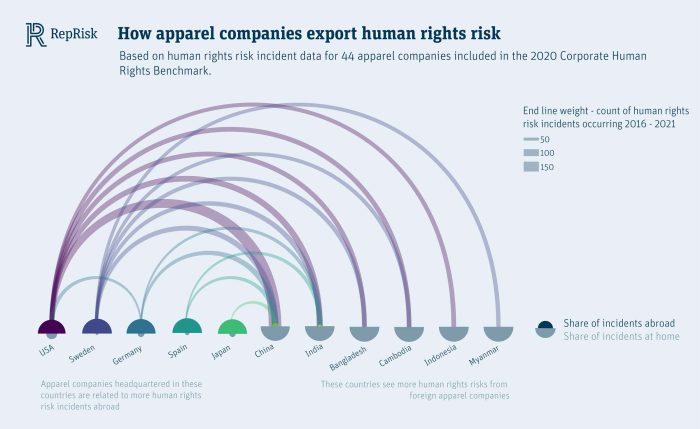Human rights risks and the need for an outside-in perspective

Our Corporate Human Rights Benchmark is informed by research and data from a few different organisations. One of these is RepRisk, a leading business intelligence provider specialising in environmental, social and governance risk analytics and metrics. RepRisk provide us with information that informs our assessment on how companies respond to company allegations. In today’s blog, RepRisk outlines the importance of measuring how companies manage their human rights risks, and explains how the organisation gathers and analyses its data.
While it might seem obvious that respecting human rights and managing related risks is standard practice for businesses, the reality is that many companies and market practitioners lack even a formal human rights policy. For example, according to ShareAction, an estimated 70% of the world’s largest asset managers do not have a policy to exclude or engage with companies in line with international human rights frameworks.
Identifying and assessing material human rights risks under
Measurement Theme E
RepRisk takes a unique outside-in approach to Environmental, Social and Governance (ESG) risks, analysing how companies conduct their business on the ground using information from public sources and stakeholders, rather than company self-disclosure. Because of this, RepRisk’s data has been incorporated into the Corporate Human Rights Benchmark’s (CHRB’s) serious allegations assessment – now Measurement Theme E – since 2018. Theme E focuses on company responses to allegations of serious negative impacts on human rights using external sources of information to assess each company included in the CHRB iterations. By excluding company self-disclosures from our research and relying exclusively on third-party sources to identify and assess ESG risks, RepRisk’s perspective allows the CHRB to avoid the ‘disclosure gap’ that occurs when one solely relies on company disclosures. This provides CHRB with an unbiased look onto company blind spots.
How does it work in practice?
Given the sensitive and often intangible nature of social issues, it’s crucial to detect and assess risks early on at the local level. That’s why RepRisk leverages Artificial Intelligence and machine learning to screen more than 100,000 sources in 23 languages every day for ESG issues – from local sources such as non-governmental organisations (NGOs), government agencies, blogs, and news sites to international media. Our research scope covers social issues, including forced labor, child labor, social discrimination, discrimination in employment, poor employment conditions, freedom of association, occupational health and safety issues, and impacts on communities.
Identified ESG risk incidents are tagged with the specific ESG issues and associated companies. They are then further curated by human analysts with proficiency in the source language to ensure that the events and criticism are accurately assessed based on RepRisk’s rules-based methodology. Each risk incident is scored according to:
- its severity (how serious is the incident or criticism?)
- reach of the information source (influence based on readership as well as by its importance in the specific country),
- and novelty (newness of the issue addressed for the company).
For CHRB’s serious allegations assessment under Measurement Theme E, RepRisk provides a dataset with severe and very severe risk incidents on social issues. This includes detailed research and analytics on benchmarked companies with a 3-year history, allowing the CHRB to assess whether and how companies have responded to allegations of serious negative impacts on human rights.
What the data tells us: a sector analysis
In light of the revised CHRB methodology, RepRisk took a closer look at what our data tells us about the status of human rights risk management for the companies included in the 2020 CHRB. When it comes to negative allegations of human rights risk incidents, what do these look like in practice? For more details on the RepRisk methodology, research scope, and incident scoring, visit reprisk.com.
Using the information, communications, and technology (ICT) manufacturing sector as an example, the types of alleged impacts covered include:
• Privacy violations: The supply of surveillance technologies to repressive regimes, as well as data breaches and misuse of personal information.
• Conflict minerals: Companies knowingly sourcing cobalt from suppliers employing child labor.
• Salaries and benefits: Labor law violations regarding fair and equal pay.
• Migrant labor: Companies and their suppliers subjecting migrant workers to harsh working and living conditions.
The graph below shows a sector analysis of how 200 companies included in the 2020 CHRB perform when assessed on their reported violations of international human rights norms and standards. For each sector, a selection of representative ESG issues is highlighted.

Case study: How the apparel industry ‘exports’ human rights risks
The apparel industry is not only infamous for its impact on environmental issues (they are responsible for 10% of global CO2 emissions), but also because of its lengthy and complex supply chains, making it prone to hidden ESG risks.
Many apparel companies are headquartered in countries far away from the factories where their products are manufactured, resulting in the large-scale exportation of human rights risks. This phenomenon has unfortunately only increased with the rise of fast fashion. Frequent types of alleged impacts in the sector include those related to salaries and benefits, migrant labor and privacy violations.
The following graph shows the extent to which risk incidents related to human rights abuses and corporate complicity in the apparel industry are exported from companies’ headquarters, often in in advanced wealthy democracies, to their suppliers who are mostly in underdeveloped nations. Using five years of human rights risk incident data for 44 apparel companies included in the 2020 CHRB Benchmark, we found that 81% of all human rights incidents are associated with a country other than the company’s headquarters.

What gets measured gets managed
Companies that fail to identify and comprehensively address or prevent human rights abuses and corporate complicity related issues risk material, bottom-line financial, compliance, and reputational damage. What’s more, they fail to recognize the interconnectedness of social, environmental, and governance issues.
Companies and investors require data that tells them whether companies truly ‘walk their talk’ on respecting human rights across their operations and supply chains around the world. Outside-in data can empower them to identify a company’s material human rights risks and take the necessary mitigation actions. RepRisk is proud to partner with the CHRB on this important work to ensure that the benchmarks remain a solid and meaningful assessment.
This blog is a part of a series that delves into the different elements of our revised Corporate Human Rights Benchmark Methodology, which was published on 30 September 2021.


